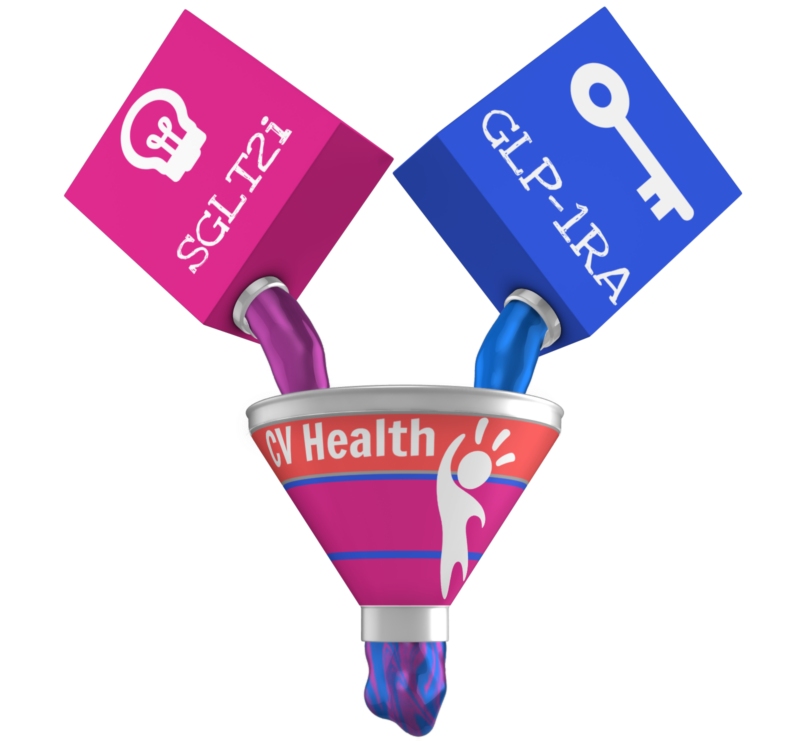22nd March 2022, Dr Chee L Khoo

If you don’t already know that SGLT2 inhibitors (SGLT2i) have significant cardiovascular (and renal) benefits over and above its glucose lowering action, you better catch up with our many, many past issues at GPVoice. You should also be as familiar with the similar benefits of the GLP1 receptor agonists (GLP-1RA), especially the newer weekly injectables. In theory, since the two classes of agents work via different mechanisms, combining them should have additive benefits with glucose lowering as well as cardiorenal complications. Of course, data on combination therapy is still coming in and we know that there is often a lag with TGA and PBS approval for usage of both classes of agents in type 2 diabetes (T2D). However, in practice, does combination therapy make that much of a clinical difference and should we be combining a GLP-1RA with a SGLT2i?
Cardiovascular benefits of SGLT2i
The original cardiovascular outcome trials demonstrated that SGLT2 inhibitors is associated with a reduction of composite major adverse cardiovascular events (MACE) especially in hospitalisation for heart failure (HF). Subsequent dedicated heart failure trials have demonstrated significant benefits in patients with heart failure with reduced ejection fraction (HFrEF) (DAPA-HF and EMPA-REDUCED). A more recent HF trial have demonstrated similar benefits in patients with heart failure with preserved ejection fraction (HFpEF) (EMPA-PRESERVED). We comprehensively covered the issues here in December 2021.
Cardiovascular benefits of GLP-1RA
Hot on the heels of the SGLT2i, GLP-1RA have also been associated with reduction in MACE but in this case, it appears to be more in patients with established athero-sclerotic cardio-vascular disease (ASCVD) or at multiple risks for ASCVD. These issues were also covered in July 2020 when we explored semaglutide weekly. We also explored the reduction of non-fatal stroke with dulaglutide weekly back in March 2020.
Combination therapy?
So, it would seem that the SGLT2i target the myocardium while the GLP1RA target the arteries. It would be sensible to combine both agents since their mechanisms of action and targeted outcomes are different and complimentary.
Alison Wright et al looked at primary care data from the Clinical Practice Research Datalink from England and Wales. They explored associations between current use of SGLT2i, GLP-1RAs, and their combination and risk for major adverse cardiac and cerebrovascular events (MACCE) and heart failure (HF) in people with type 2 diabetes.
Among 336,334 people with type 2 diabetes and without cardiovascular disease, 5.5% experienced a MACCE. In a cohort of 411,206 with type 2 diabetes and without HF, 4.2% experienced an HF event.
SGLT2 inhibitor regimens was associated with a 18% in MACCE while GLP-1RA was associated with a 7% reduction in MACCE. When you combined both agents, the reduction in MACCE of 30%. The corresponding data for HF was SGLT2i 51%, GLP-1RA 18% and combination 47%.
The study suggests that combining both SGLT2i with a GLP-1RA is more beneficial than either agents alone in reducing MACCE and HF. The only problem is that PBS doesn’t allow us a combination regimen. You could “circumvent” this by prescribing a SGLT2i as a private prescription and leaving the GLP-1RA on PBS Authority. If the patient has HRrEF and have symptoms of HF, you can prescribe a GLP-1RA on PBS if the HbA1f is > 7.0% and prescribe Dapagliflozin on PBS authority for HF. You can have your cake and eat it.
Reference:
Alison K. Wright, Matthew J. Carr, Evangelos Kontopantelis, Lalantha Leelarathna, Hood Thabit, Richard Emsley, Iain Buchan, Mamas A. Mamas, Tjeerd P. van Staa, Naveed Sattar, Darren M. Ashcroft, Martin K. Rutter; Primary Prevention of Cardiovascular and Heart Failure Events With SGLT2 Inhibitors, GLP-1 Receptor Agonists, and Their Combination in Type 2 Diabetes. Diabetes Care 2022; dc211113. https://doi.org/10.2337/dc21-1113
